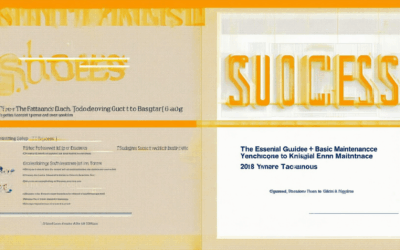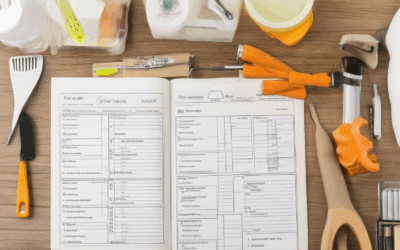Owning a home comes with a multitude of responsibilities, and keeping it in top shape can sometimes feel overwhelming. However, with the right DIY house maintenance tips, you can take control of your home environment without needing to call in professionals. From fixing minor leaks to repainting walls, there are countless tasks around the house that you can tackle confidently. Not only do these DIY solutions save you money, but they also empower you to maintain your space in a way that boosts both functionality and aesthetics. Whether it’s preparing your home for winter or tackling spring cleaning projects, having a solid understanding of basic household repairs and maintenance can transform the way you approach home care. In this guide, we’ll explore essential DIY house maintenance tips every homeowner should know, providing practical advice and actionable steps to keep your property in excellent condition year-round.
Key Takeaways
– Prioritize Plumbing Checks: Regularly inspect pipes for leaks to prevent costly repairs and maintain water flow.
– Ensure Electrical Safety: Test GFCI outlets and update outdated wiring to safeguard your home and family.
– Schedule HVAC Tune-Ups: Clean or replace air filters monthly and schedule annual services to boost energy efficiency and comfort.
– Prepare for Seasons: Clear gutters, trim trees, and prepare for seasonal challenges to avoid damage and ensure proper drainage.
– Enhance Energy Efficiency: Inspect windows and doors for drafts and upgrade to energy-efficient models to reduce utility bills.
– Maintain Landscaping: Keep lawns tidy, prune trees, and clear gutters to protect your home’s foundation and curb appeal.
– Budget for Repairs: Set aside funds for unexpected issues and address minor problems early to prevent major breakdowns.
– Plan Home Improvement Projects: Tackle small tasks like painting or kitchen updates using the right tools for safer, better results.
– Stay Prepared for Emergencies: Keep a toolkit ready for minor repairs and know when to call professionals for serious incidents.
– Consult Experts When Needed: Don’t hesitate to seek professional help for complex tasks to ensure safety and effectiveness.
By focusing on these key areas, homeowners can maintain their homes more efficiently, saving time and money while ensuring a safe and comfortable living environment.

Improving and Maintaining Your Home with DIY Tips
Keeping your home in great shape doesn’t require professional help. With the right knowledge and a bit of effort, you can tackle many home maintenance tasks yourself. Here are some practical DIY tips to help you:
- Inspect Your Home Regularly: Start by walking through every room to identify any visible issues like peeling paint, water stains, or damaged flooring. Addressing these early can prevent costly repairs later.
- Declutter and Organize: A clutter-free space is easier to maintain. Use storage boxes and shelves to keep tools and supplies neatly stored. Consider labeling boxes for quick access.
- Clean and Maintain: Regular cleaning prevents dirt buildup and extends the life of your surfaces. Use a mix of white vinegar and baking soda for effective cleaning without harsh chemicals.
- Yard Care: Maintain your lawn by mowing regularly and fertilizing based on your soil type. Trim trees and bushes to keep your yard looking neat. Rent a lawnmower or borrow one from a neighbor if needed.
- Fix Small Issues: Replace loose handles on cabinets, fix leaky faucets, and repair small holes in walls. Follow online tutorials for step-by-step guides to ensure safety and effectiveness.
- Check HVAC System: Clean or replace air filters monthly to improve indoor air quality. Inspect ductwork for leaks, but avoid damaging it. Use online resources for guidance.
- Minor Repairs: Handle simple fixes like changing a light switch or fixing a leaky faucet. Test outlets before working on them to ensure safety. For larger tasks, consult a professional if unsure.
- Seasonal Preparation: In winter, inspect the roof for damage and wrap pipes to prevent freezing. In summer, check for pests and ensure gutters are clear. Use binoculars to inspect hard-to-reach areas.
- Appliance Upkeep: Read appliance manuals for troubleshooting. Regularly clean and maintain your stove, refrigerator, and other appliances to prevent breakdowns.
- Security Checks: Test smoke detectors and carbon monoxide alarms. Ensure locks and windows are secure. Add motion-activated lights to deter intruders.
- Budget-Friendly Options: Shop for affordable, high-quality tools and materials. Compare prices and read reviews to avoid poor products. Use coupons or discounts when possible.
- Stay Informed: Subscribe to DIY newsletters, follow YouTube channels, and join online communities for tips and advice. Engage with local handyman groups on social media for recommendations.
- Network and Learn: Ask neighbors for advice and borrow tools. Connect with online communities to gain expertise and find mentors who can guide you through complex projects.
- Know When to Seek Help: Don’t hesitate to hire professionals for tasks you’re uncomfortable tackling, such as electrical work or roofing. Your safety and home’s integrity are worth it.
By starting with small projects, learning as you go, and seeking help when needed, you can confidently maintain your home and improve its condition without relying on professional services.
What Are Some DIY House Maintenance Tips Everyone Should Know?
We’ve compiled a list of essential DIY house maintenance tips to help you keep your home in great shape. These tips will guide you through routine tasks that can prevent costly repairs and extend your home’s lifespan.
- Check Pipes for Leaks – Regularly inspect pipes under sinks, around faucets, and behind appliances. A small leak can lead to significant water damage.
- Clear Gutters – Clean out rain gutters twice a year to prevent clogs and water overflow, which can damage your roof and siding.
- Test Smoke Detectors – Replace batteries in smoke detectors annually and check their functionality to ensure your family’s safety.
- Inspect Windows – Look for cracks or drafts in windows. Caulk or replace them as needed to improve energy efficiency and prevent drafts.
- Trim Trees and Shrubs – Keep trees and shrubs trimmed to avoid branches breaking or sagging onto your roof or power lines.
- Clean Air Filters – Regularly clean or replace air filters in HVAC systems to ensure efficient heating and cooling.
- Check Grout Lines – Inspect grout lines in bathrooms and kitchens for cracking or discoloration, which can indicate moisture issues.
- Inspect Foundation – Look for signs of wear or damage along the foundation, especially after heavy rains or snow melts.
- Service Appliances – Schedule regular maintenance for HVAC, refrigerators, and major appliances to prevent breakdowns.
- Seal Driveways and Walkways – Fill cracks in driveways and walkways with sealant to prevent tripping hazards and further damage.
- Pest Control – Monitor for pests like ants, spiders, and rodents. Use natural deterrents or traps to keep them away.
- Energy Efficiency Checks – Test doors and windows for energy loss and consider upgrading to more efficient models if needed.
For tools and supplies, consider visiting retailers like Amazon , Home Depot , Lowe’s , and Menards for a wide selection of DIY essentials.
By staying proactive with these maintenance tasks, you can save time and money while ensuring your home remains in excellent condition. Remember to always prioritize safety and consult professional guides if you’re unsure about a task.

Essential DIY House Maintenance Tips Every Homeowner Should Know
Keeping your home in great shape requires regular maintenance. Here are some essential DIY tips to help you tackle common tasks effectively:
- Plumbing Checks: Regularly inspect pipes for leaks. Use a wrench to tighten connections or call a professional if needed.
- Electrical Systems: Test GFCI outlets to ensure they work properly. Replace old wiring and update outdated circuits for safety.
- Heating, Ventilation, and Air Conditioning (HVAC): Change air filters monthly to maintain efficiency and indoor air quality. Schedule annual HVAC tune-ups.
- Seasonal Maintenance: Clear gutters and drains in fall to prevent ice dams in winter. Trim trees and remove debris from roofs.
- Energy Efficiency: Inspect windows for drafts and consider upgrading to energy-efficient models. Check doors for proper sealing.
- Landscaping: Maintain lawn care routines, prune trees, and clean gutters to keep your property looking great year-round.
- Budgeting for Repairs: Set aside funds for unexpected repairs. Prioritize minor fixes to avoid major issues later.
- Home Improvement Projects: Plan small projects like painting or kitchen updates. Use tools like paint sprayers and sanders safely.
- Emergency Preparedness: Keep a tool kit handy for minor repairs. Know when to call professionals for serious issues like gas leaks.
By staying proactive with these maintenance tasks, you can extend your home’s lifespan and save money in the long run. Always prioritize safety and consult professionals when unsure about complex repairs.
For more detailed guides and resources, visit Example Maintenance Guide or explore trusted DIY communities online.

Essential DIY House Maintenance Tips Every Homeowner Should Know
Keeping your home in great shape requires regular maintenance. Here are some essential DIY tips to help you tackle common tasks effectively:
- Plumbing Checks: Regularly inspect pipes for leaks. Use a wrench to tighten connections or call a professional if needed.
- Electrical Systems: Test GFCI outlets to ensure they work properly. Replace old wiring and update outdated circuits for safety.
- Heating, Ventilation, and Air Conditioning (HVAC): Change air filters monthly to maintain efficiency and indoor air quality. Schedule annual HVAC tune-ups.
- Seasonal Maintenance: Clear gutters and drains in fall to prevent ice dams in winter. Trim trees and remove debris from roofs.
- Energy Efficiency: Inspect windows for drafts and consider upgrading to energy-efficient models. Check doors for proper sealing.
- Landscaping: Maintain lawn care routines, prune trees, and clean gutters to keep your property looking great year-round.
- Budgeting for Repairs: Set aside funds for unexpected repairs. Prioritize minor fixes to avoid major issues later.
- Home Improvement Projects: Plan small projects like painting or kitchen updates. Use tools like paint sprayers and sanders safely.
- Emergency Preparedness: Keep a tool kit handy for minor repairs. Know when to call professionals for serious issues like gas leaks.
By staying proactive with these maintenance tasks, you can extend your home’s lifespan and save money in the long run. Always prioritize safety and consult professionals when unsure about complex repairs.
For more detailed guides and resources, visit Example Maintenance Guide or explore trusted DIY communities online.
What DIY House Maintenance Tasks Should Every Homeowner Prioritize?
Homeownership requires ongoing maintenance to ensure your property remains safe, comfortable, and efficient. Here are the key DIY tasks every homeowner should prioritize to preserve their investment and enhance living quality.
- Inspect and Maintain the Roof : Check for damaged shingles, missing granules, or sagging areas. Clean gutters and ensure they’re free from debris to allow proper water drainage.
- Schedule HVAC System Service : Replace or clean air filters monthly to improve indoor air quality and energy efficiency. Plan annual tune-ups to maintain peak performance.
- Check Water Heater Functionality : Inspect for leaks or rust around the tank. Test the pressure relief valve to prevent potential issues.
- Examine Exterior Walls : Look for cracks, peeling paint, or signs of moisture. Replace caulkings and repaint surfaces as needed to maintain protection against the elements.
- Manage Landscaping and Drainage : Trim trees and bushes to prevent blockages. Clear clogged gutters and downspouts to ensure proper water runoff and avoid foundation damage.
- Inspect the Foundation : Look for cracks or gaps caused by shifting soil. Apply sealant to protect against water infiltration and structural issues.
- Check Appliance Hoses : Examine hoses connected to refrigerators, dishwashers, and laundry machines for cracks or kinks. Replace any that are worn out to prevent water damage.
- Test Smoke and Carbon Monoxide Detectors : Ensure these devices are functioning properly and replace batteries as needed to maintain safety in your home.
- Inspect Flooring : Look for loose tiles, warping, or uneven surfaces. Address issues promptly to prevent tripping hazards and structural damage.
- Review Plumbing Systems : Check for leaks under sinks, around pipes, or behind appliances. Fix minor issues before they escalate into major plumbing failures.
- Update Electrical Systems : Inspect outlets, switches, and wiring for signs of wear or damage. Consider upgrading outdated systems to improve safety and functionality.

DIY House Maintenance Tasks Every Homeowner Should Prioritize
- Inspect the Roof : Check for missing shingles, curled edges, or sagging sections. Address any damage promptly to prevent leaks and structural issues.
- Clean Gutters : Remove debris and ensure smooth drainage to prevent water pooling and foundation damage.
- Check Foundation : Look for cracks, unevenness, or movement. Early detection of issues can save on costly repairs later.
- Examine Exterior Surfaces : Inspect siding, paint, and trim for peeling, fading, or damage. Replace old paint and repair loose siding to maintain curb appeal and protection.
- Test Plumbing Systems : Check for leaks under sinks, toilets, and appliances. Replace worn-out pipes or fixtures to ensure reliable function.
- Service Heating and Cooling Systems : Clean or replace air filters monthly and check for leaks or unusual noises. Schedule professional inspections annually to ensure efficiency and longevity.
- Inspect Flooring : Look for warped boards, loose tiles, or trip hazards. Consider upgrading to more durable materials for long-term safety and aesthetics.
- Update Major Appliances : Replace outdated refrigerators, dishwashers, and stoves with energy-efficient models to reduce utility bills and extend appliance life.
- Review Electrical Systems : Test outlets and switches for functionality. Plan upgrades or replacements for older wiring to enhance safety and reduce fire risks.
- Maintain Landscaping : Trim trees and bushes, remove dead branches, and keep grass trimmed to prevent root damage and moisture buildup near the foundation.
- Inspect Windows and Doors : Check for proper seals and tight closures. Replace old windows with energy-efficient options to improve insulation and reduce heating/cooling costs.
- Examine Attics and Basements : Look for moisture, mold, or pest activity. Address issues promptly to maintain a healthy living space and prevent structural damage.
By prioritizing these tasks, homeowners can ensure their properties remain in excellent condition, reducing the need for costly repairs and enhancing overall safety and comfort.




0 Comments